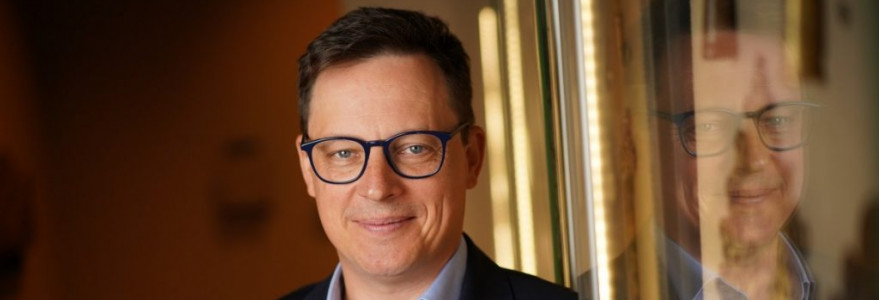Old Dongola is an archeological site in Sudan. It is located at the site of Tungul, the capital of Makuria, one of the most prominent medieval African states. The team of researchers led by Prof. Artur Obłuski from the PCMA UW discovered unique wall paintings of saints and King David, one of the last rulers of Christian Makuria. The project is carried out under a European Research Council grant.
The team of researchers, led by Prof. Artur Obłuski have conducted the project “UMMA – Urban Metamorphosis of the community of a Medieval African capital city” as part of an ERC Starting Grant. During the excavations, the researchers discovered wall painting, which depict the figures of saints. Archaeologists Dr. Lorenzo de Lellis and Dr. Maciej Wyżgoł unexpectedly stumbled upon an enigmatic complex of rooms made of sun-dried brick, the interiors of which were covered with figural scenes unique for Christian art. The discovery was made during the exploration of houses dating from the Funj period (16th-19th centuries CE). To the surprise of the researchers, beneath the floor of one of the houses was an opening leading to a small chamber, the walls of which were decorated with unique representations.
The paintings within the chamber showed the Mother of God, Christ, as well as a scene depicting a Nubian king David, Christ, and Archangel Michael. However, this was not a typical representation of a Nubian ruler under the protection of saints or archangels. David was one of the last rulers of Christian Makuria, and his reign marked the beginning of the end of the kingdom. The king bows to Christ, who is seated in the clouds. The ruler is supported by Archangel Michael, whose spread wings shield both the king and Christ himself. Such a scene finds no parallels in Nubian painting. However, similar depictions can be found on the gold coins of Michael Palaiologos minted in Byzantium between 1259 and 1282.

“The dynamism and intimacy of the representation contrasts with the hieratic nature of the figures shown on the side walls. Neither does the figure of the Virgin Mary on the north wall of the chamber belong to the typical repertoire of depictions of Mary in Nubian art. The Mother of God, shown in a dignified pose, is dressed in dark robes. In her hands she holds a cross and a book. Christ is depicted on the opposite wall. His right hand is shown in a gesture of blessing, and in His left he holds a book, which is fragmentarily preserved,” Prof. Artur Obłuski, the director of the Polish Centre of Mediterranean Archaeology, the University of Warsaw says.
The paintings are accompanied by inscriptions currently studied by Dr. Agata Deptuła from the PCMA UW. A preliminary reading of the Greek inscriptions has led to their identification as texts of the Liturgy of the Presanctified Gifts.
“Such inscriptions generally occurred in spaces outside the main altar in the church where the Holly Mass was celebrated. An inscription in Old Nubian that accompanies the main scene is extremely difficult to decipher. Thanks to a preliminary reading, the researchers learned that it contains several mentions of a king named David and a plea to God for protection of the city. The city mentioned in the inscription is probably Dongola, and King David is likely the royal figure depicted in the scene. For reasons unknown, King David attacked Egypt, which retaliated by invading Nubia and, as a result, Dongola was sacked for the first time in its history. The painting may have been created as the Mamluk army was approaching the city or already laying siege to it,” Prof. Obłuski adds.
The biggest puzzle, however, is the complex of rooms in which the paintings were found. The researchers suspect that it may have been a royal commemorative complex. The spaces themselves are made of dried brick. The room with the painted scene showing king David resembles a crypt, but it is 7 meters above the medieval ground level. The building is adjacent to a sacral building identified as the Great Church of Jesus, which was probably the cathedral of Dongola and the most important church of the kingdom of Makuria.
Further research is planned to be conducted in autumn.
The researchers led by Magdalena Skarżyńska also carried out conservation of the paintings. The conservation team operated as part of a cooperation between the Polish Centre of Mediterranean Archaeology, the University of Warsaw, and the Department of Conservation and Restoration of Works of Art of the Academy of Fine Arts in Warsaw.
Prof. Artur Obłuski received an ERC Consolidator Grant for the project “Afropolis Tungul: Urban biography of a cosmopolitan African capital”. It will be carried out for five years, starting from January 2024. The amount allocated to the project by the European Research Council is almost €2 million. The “Afropolis Tungul” project will focus on the period when the city was the capital of the Christian kingdom of Makuria (4th–15th c.), but it will also incorporate the results of the earlier ERC project, UMMA, which studied the most recent 500 years of the city. Moreover, the information gathered during other PCMA UW expeditions to the site will be used. The research has been carried out for more than five decades and is the longest-running Polish archaeological expedition in Sudan.
Prof. Obłuski is the first Polish archaeologist, who received an ERC grant twice.
More information about the “Afropolis Tungul” project can be found in the latest issue of the “UW” magazine and on the UW’s YouTube channel.
The University’s magazine “UW” nr 1 (106) 2023 (pdf) >>



